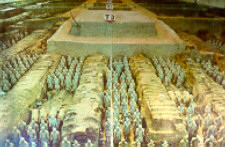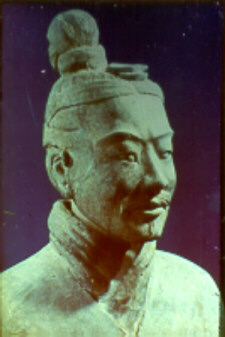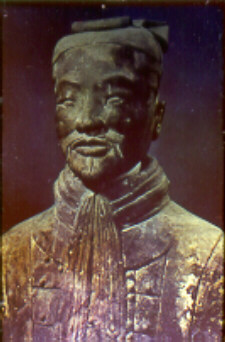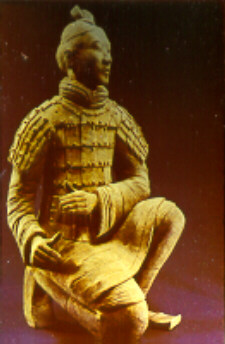
from the
Imperial Tomb of Qin Shi Huang
 |
Terracotta
Figures
from the Imperial Tomb of Qin Shi Huang |
| The
Underground Terracotta Army
of Emperor Qin Shi Huang The imperial tomb of Qin Shi Huang (259 - 210 BC), the first Emperor of China and founder of the short-lived Qin (Ch’in) Dynasty, lies 35 km east of Xi’an in Lintong County, Province of Shaanxi. In 1974, peasants digging a well uncovered an underground vault of earth and timber that eventually yielded thousands of life-size terracotta soldiers and their horses in battle formation. In 1976, two other, smaller vaults were discovered close to the first one. These exquisite pottery figures from the Qin Dynasty not only reproduce a majestic view of the then Qin State leading “an army one million strong, with one thousand chariots and ten thousand horses” fighting in the battlefield to unify China, but also display the remarkable achievements of Qin Dynasty sculpture over two thousand years ago. The bronze weapons unearthed here remains sharp and shiny with metallic luster despite two thousand years of burial in earth. Emperor
Qin Shi Huang was a man with a quest for immortality and eternal glory
and power. He declared himself emperor in 221 BC, after defeating
six warring states and unifying China. He
Six thousand terracotta figures of warriors and horses face east in a rectangular battle array. The vanguard appears to be three rows of 210 crossbow and longbow bearers who stand at the easternmost end of the army. Close behind is the main force of armored soldiers holding spears, dagger axes and other long-shaft weapons, accompanied by 35 horse-drawn chariots. Every figure differs in facial features and expressions. The horsemen are shown wearing tight-sleeved outer robes, short coats of chain mail, and windproof caps. The archers have bodies and limbs positioned in strict accordance with an ancient book on the art of war. The discovery
of the Terracotta Army buried near the Emperor’s tomb on the slopes of
Li Mountain is regarded as one of the most spectacular archaeological finds
of the 20th Century. Thousands of life-sized warriors and horse figures,
equipped with chariots and bronze weapons, were created 2,200 years ago
to serve the Emperor in his afterlife. They lay buried, undisturbed,
until they were unearthed in 1974.
|

View of Warriors in Tomb
|
 |
 |
 |